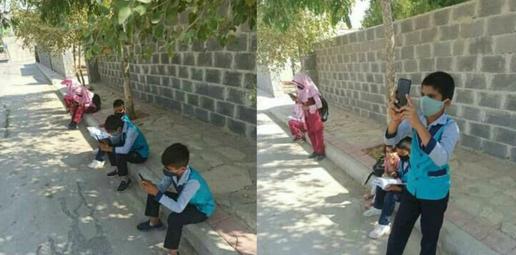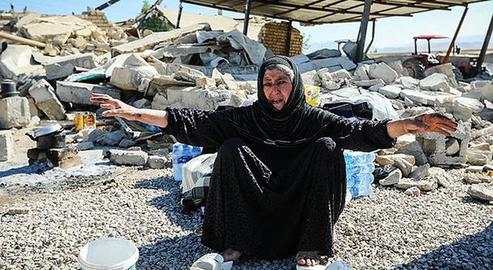The bloody face of a young boy who fell in the mountains while trying to get to a village with internet access is the latest image to symbolize how hard it is for rural children in Iran to get an education. It follows the recent news that a child committed suicide because his family couldn't afford to pay for him to access an app he needed for school.
Iranians shared the photograph of the boy on social media. Determined to access the internet so he could participate in online classes, on Saturday, November 7, the boy set off by foot from the village of Romashtik in South Khorasan province, where his family had gone for work harvesting saffron. But the route to the nearest place with internet access was treacherous, via steep mountain passes, and on the way, his foot slipped and he fell.
Talking to the Iranian Students News Agency (ISNA), the boy’s sister confirmed that her brother had made the journey because he had to download files for school. “On the first day of our stay in the village, my brother found out the village did not have internet access. So he went up the mountain with his friend to download the content for school. His foot slipped and he fell several meters and his head was injured.”
But Mohammad Ali Vaghei, director general of education in South Khorasan, said the boy had not been walking in the mountains to do anything for school. He told IRNA that it was true that many villages in the province did not have access to the internet, but that the student had made his journey at a time when classes were not online anyway. The family lives in the village of Nowghab near Hajiabad, 24 km from Ghaen Shahr, but, like many from their village, they traveled to Romashtik for seasonal work. Vaghei claimed that the boy injured himself while harvesting saffron, and that the family's claim that he was making the journey for educational reasons was simply an attempt to get compensation. But the family insist he was definitely making the journey as part of his schooling, and that it was nothing to do with saffron harvesting.
Children’s education, and particularly education for children in rural areas, is always a popular (and contentious) topic of conversation in Iran. Poor families face a huge range of obstacles when trying to ensure their kids get an education. This year, the situation has been made worse for many because of the coronavirus pandemic, and although many children continued to go to school, many did not. In April, the government launched its online education app, Shad, but it failed to address the problem of access: many children in Iran do not have access to the internet, smartphones or tablets.
Unfortunately, the story of the boy from Ghaen Shahr is not an isolated one. In fact, on most days, there are stories and photographs on social media paying testament to the hardship young students face, including difficulties getting online. Children in rural villages across the country walk miles, often across dangerous terrain like the one the boy from Ghaen Shahr crossed, often in freezing weather, to get the materials they need, or to complete schoolwork. And these stories shared are presumably just a fraction of the huge number of children’s lives affected by lack of access to education.
Below are a few of the stories that Iranians have shared online.
Children from the village of Darreh Bid in Kiar county, Chaharmahal and Bakhtiari province in southwestern Iran, are forced to walk along dangerous roads for 20 kilometers to a nearby valley where they can connect to the internet and access the Shad network.
The children of Golzamin village near the city of Avaj in Qazvin province, northern Iran, can only get reception to go online on the tops of the hilly terrain around where they live.
Children in the village of Khomi near Bardaskan in Khorasan Razavi province, northeastern Iran, must also travel dangerous mountain roads to access the internet.
Children from the village of Kahran in Komijan county and from Yasbolagh in Ojur Sarein county, both in the province of Ardabil, are forced to leave their areas in order to get suitable network coverage.
As with the Ghaen Shahr incident, local officials routinely dismiss, ignore or deny these accounts, refusing to acknowledge the risks children take to get an education.
Children and Suicide
Over the last few months, there have been numerous reports of children taking their lives because they have been unable to access the education they need or have been isolated from their fellow classmates. The pressures of poverty and a bleak future are too much for many of them to bear.
One of the most widely-reported stories was the suicide of Mohammad Mousavizadeh, an 11-year-old student from Daeir in Bushehr province. According to his family, the boy was desperate, and suffered from increasing pressure because he did not have the cell phone required to do his homework. Distraught, he killed himself.
Education officials from Bushehr province denied that students were required to have phones to do their schoolwork, and at any rate, people had donated phones for this purpose. In interviews with the media, Mohammad Mousavizadeh’s parents denied the claim that their son had access to the phone he needed to continue his education.
Once this story surfaced, others followed.
After the student from Daeir killed himself, other news was published about students who committed suicide for the same reason, including a 10-year-old boy called Morteza from a poor family in a village in Ilam province, and Mobina, a 10-year-old Afghan immigrant living in Tehran's Hajiabad neighborhood, and 13-year-old Parastou, who lived in the village of Hesar in West Azerbaijan. All were poor, and none of them had access to educational facilities.
Other suicides appear to have been linked to a game called “Momo Challenge.” Mani, an 11-year-old Ahvazi student, died of a heart attack, but the media had reported that he had repeatedly spoken about his intense fear of Momo, the game’s character, before his death.
Taha, a 12-year-old student whose family had recently moved to Tehran's Parand town, also committed suicide, and his death was also linked to “Momo Challenge.”
Students up Against the Elements — and Violence
Schoolchildren face multiple risks when they set out to face the elements and harsh terrain to access the internet. But they also face other dangers, including violence and theft.
IranWire spoke with Naimeh Kiasari, who lives in a village near Ashkhaneh in North Khorasan. She said she had struggled to get a cell phone for her son Salman so that he could attend online classes.
She said Salman was forced to go out in the desert surrounding the village to get access to the internet. On one of these occasions, he was attacked and mugged, and his cell phone was taken from him.
"He hit my son in the back and on his legs with a stick," she said. "Salman, who knew how hard it was for me to buy this phone, had fought off the thief until the last moment. He was severely beaten. The thief was ruthless, and left him for dead. But God had mercy on us and Salman was just unconscious. A passerby saw him, called the police and took him to the hospital. My son is in pain and will not be able to stand on his feet for months. I must also worry about paying the stolen phone’s installments. I have to try to buy a new phone for my child because I do not want him to miss school.”
A Long-Running Insurance Scam?
Naimeh Kiasari told IranWire that although the education authorities said the classes were free, her son was forced to pay 10,000 tomans in accident insurance at the time of registration. "Now that I have referred to the education department to help me with my son's treatment expenses, they say they will not be able to pay more than two million tomans. They said: ‘And still you should be happy, because it happened to him outside school hours.’"
When enrolling in school, students pay an average of between 6,000 and 10,000 tomans for accident insurance. In other words, 15 million students in Iran pay a total of more than one hundred billion tomans [$4m] for accident insurance. Such insurance has been compulsory for all students since 1982.
Mohammad Hossein Armani, an insurance expert based in Iran, says that although this amount is given to the insurance company, the education department undoubtedly makes a profit from it as an intermediary.
According to this expert, this insurance covers accidents as well as unintentional damages. "This means that if there is a conflict between two students at school, the insurance company will pay the unintentional damage to the other party up to a certain limit."
He also explained that there is a ceiling for pay-outs in cases involving disability, injury, outpatient treatment or hospitalization costs.
Naimeh Kiasari says her son was studying online and was not at school at the time, so the insurance company has only agreed to pay two million tomans for his treatment.
On paper, she said, the premium for the insurance was 7,000 tomans this year, but she paid 10,000. Despite paying this, the insurance company refused to provide the support her child needed.
In recent years, the education department’s insurer has been the Teacher's Insurance Company. If a student dies, it pays ten million tomans in compensation. This insurance is also paid for disabled students; the ceiling for payments to disabled students is one hundred million tomans [$4,000].
According to Mohammad Hossein Armani, the company also pays for the treatment of incurable diseases or the cost of a kidney transplant, but the amount paid to the injured student is so small and insignificant that it is practically useless. "Three million tomans [$120] will be allocated to each student for treatment or kidney transplant, which is an irrational and insignificant amount."
According to him, unlike in most countries, students in Iran cannot choose an insurance company other than the one designated by the Ministry of Education.
Students who have incidents related to online classes do not have any financial support. The Teacher's Insurance Company only pays ten million tomans [about $400], even to the family of a student who has committed suicide or died for some other reason while studying. This is a small amount, especially given the current economic climate in Iran.
visit the accountability section
In this section of Iran Wire, you can contact the officials and launch your campaign for various problems


























comments